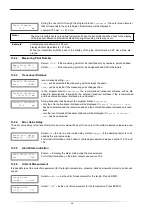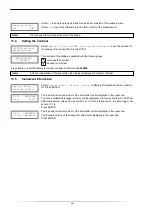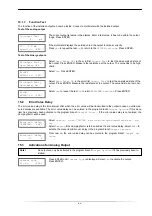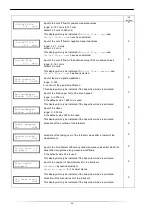
67
Enter the pulse value. The unit of measurement will be displayed according to the current
physical quantity.
When the totalized physical quantity reaches the pulse value, a pulse will be emitted.
Enter the pulse width.
The range of possible pulse widths depends on the specification of the measuring instru-
ment (e.g., counter, PLC) that is to be connected to the output.
The max. flow that the pulse output can work with will be displayed now. This value is calculated on the basis of the en-
tered pulse value and pulse width.
If the flow exceeds this value, the pulse output will not function properly. In this case, the pulse value and the pulse width
have to be adapted to the flow conditions.Press ENTER.
15.5
Activation of a Binary Output as an Alarm Output
Select
yes
to activate the alarm output. Press ENTER.
15.5.1 Alarm Properties
The switching condition, the holding behavior and the switching function of an alarm output can be defined.
Three scroll lists will be displayed:
•
func
: switching condition
•
typ
: holding behavior
•
mode
: switching function
Press key
to select a scroll list in the upper line. Press key
to select a list item in the lower line.
Press ENTER to store the settings.
Tab. 15.4: Alarm properties
alarm property
setting
description
func
(switching condition)
MAX
MIN
+→
- -
→+
QUANT.
ERROR
OFF
The alarm will switch if the measured value exceeds the upper limit.
The alarm will switch if the measured value falls below the lower limit.
The alarm will switch if the flow direction changes (sign change of measured value).
The alarm will switch if totalizing is activated and the totalizer reaches the limit.
The alarm will switch if a measurement is not possible.
The alarm is switched off.
typ
(holding behavior)
NON-HOLD
HOLD
If the switching condition is not true anymore, the alarm will return to the idle state
after approx. 1 s.
The alarm remains activated even if the switching condition is not true anymore.
mode
(switching function)
NO Cont.
NC Cont.
The alarm is energized if the switching condition is true and de-energized if idle.
The alarm is de-energized if the switching condition is true and energized if idle.
Note!
If no measurement is made, all alarms will be de-energized, independently of the programmed
switching function.
Note!
The menu item
Alarm Output
will only be displayed in the program branch
Output Options
if an
alarm output has been installed.
Pulse Value
0.01
m3
Pulse Width
100
ms
Alarm Output
no
>YES<
R1=FUNC<typ mode
Function:
MAX















































